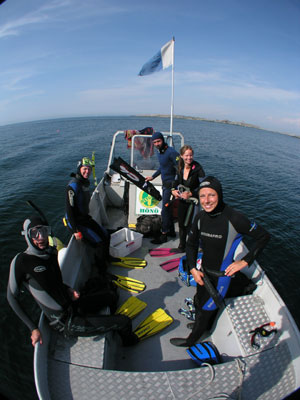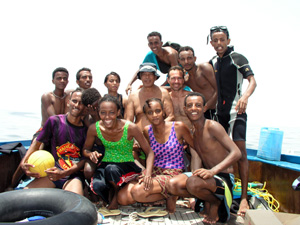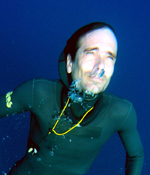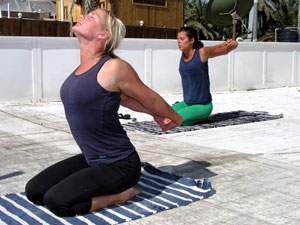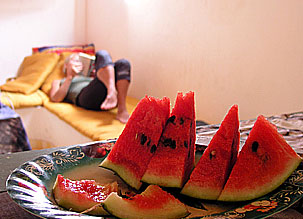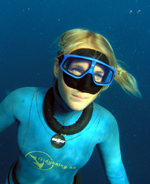|
|||||||||||||||||
|
From
beginner to 86 meters in two years.
I am
not known for being the: “you can do it”, “everything is
possible” kind of coach. At the time Lotta Ericsson was
showing world class performances (2005) having done a 70
meter dive in the only discipline Annelie considered
real freediving: CWT. As deep as you can with fins on
one breath. I said I could take her to 50, maybe 60. I underestimated all parties involved. What I missed was her determination and her willingness to actually train. Actually trying out all new approaches to freediving that the later years had produced and I had been trying out on myself. She was prepared to go the full length.
I was closely following the world top tens performances pondering on what to learn from them. Two weeks with Rudi Castineyra at a world record attempt made me realize that they (at the time) was in the forefront of warming up techniques (things that everyone know today). By the line in Ibiza WC I saw Herbert doing things that showed he was one of the pioneers: packing and hook breathing that no one else was really doing. I paid close attention to what Fattah were saying (even though I could not grasp all). All this was of course before Annelie had heard of competitive freediving. But to sum it up: all the time I spent thinking - Annelie spent training. Her morning jog of 10k was not even part of her training scheme, it was just extra training, the real training came later in the day. But on the whole here training has never come close to what rumour says Natalja is doing. But I soon realized what Annelie had already found out: “rules that apply to others does not necessarily apply to her”. She moved to Dahab for some time working with freediving for Desert Divers. This troubled me since the closeness to deep warm waters might get her caught up in a PB race. Going for max all the time. A habit that will make you miss some essential basic training needed for greater performances in the future. (All through the process I have been totally convinced that at a certain level of freediving you go deeper with 30 days training on dry land (and pools) and only one day deep diving, than 30 days deep diving). As soon as you learn to pressurize the lungs and simulate depth – this training can start.
The
other stuff As a coach your job is not only to solve the current problem (the main limiting factor) but to fore see what the next one will be. In the end of the day it is about caring about a persons dreams (taking them seriously), worry about their health and training. And since Freediving is such a mystery still, just nod and respond: "good idea let’s try it". Most of the time we know what has to be done, but sometimes there is a leap of faith needed to actually to do it. Sometimes one has to do something strange that only in the end makes sense. My basic idea (as it evolved while diving with Annelie) is that the body is ready for great depths if the right responses can be triggered – size and shape is of less importance. Actually I believe a beginner freediver can name any depth as a goal – the rest is about: time and money. What are you willing to sacrifice? The hydrodynamics was soon in place due to a flexible body (that most women seem to be gifted with). In 2003 Kirk told me that hydrodynamics would be the ultimate limiting factor. I concluded one had to work with both surface and body friction.
After 75 it was mostly about fine tuning the 17 factors that we had discovered makes up a good dive. Lots of people have the orthodox principle of only improving a meter at a time – but I believe that if the right preparation has been done and the right mental state can be summoned: a 75 meter dive is not much different from an 85 meter dive. It’s just a leap of faith. A mental journey. “Release the handbrake” as Umberto once told me. If the option is to increase a meter a day during three dive days, I would rather say: stay on land for two days and rest and add five meters the last and only diving day. But this only refers to top level freedivers who knows their bodies and the sensations of depth. Many of these things related to “the leap of faith”, was proven to me by Murat, not only theoretically, but hands on.
I have actually never told Annelie to do any thing, it has always been her own final decision how to train. At one point I realized she was actually willing to do as I told her, and that made me hesitate and be very sparse with my advice. Training has always to be guided by intuition. Since the key issue is body awareness, one will know what and how to train if one pays very close attention to what happens in ones body at all times. To phrase it slightly more poetic: the sea will tell you what to train and at what depth you should set the line. Just do one warm-up hang at your depth of choice and hang there and listen very carefully. Do you hear a voice that says: "How could you possible do what other with stronger bodies have failed to do? This is not the day for a PB – feel your weaknesses". Well don’t listen to that. Do you perceive a distant echo of: "you can do it - you’re a star". Pay no attention to that either, it’s probably some mental remnants of a bad Hollywood movie. There are other attitudes to use. There are no perfect days, there are no perfect dives – there is just the pursuit of perfection. Paying attention to thought and movement. Cherish the actual moment. Stop looking for excuses – just do it to the limit of your power that day. What ever the outcome, it will be part of your future success.
Afterwards she asks what the world record is. Natalja has it at 86 meters, I told her. Her positive attitude and belief in herself seems to be never ending and she felt it was within reach there and then. Just another weeks training. I was rather sceptical and suggested a very specific training schedule for six months aiming at a peak in the autumn of 2007. So be it, she spends the summer doing her “home-work”. Work and illnesses delay progress. Courses and working with competition steals energy. I tell her what I deem necessary for a WR attempt: Move all weights to neck, reduce suit, skip mask, skip your in water warm ups, reduce BMI – to this list she adds: alkaline diet. She sees some logic in my advice and makes an effort to change, but she is soon back to more weights, full suit, mask and at least two warm ups. I also thought it a good idea to aim for a PB of 5.30 in static and 150 in DYN in order to approach apnea from another angle and bring new skills back into CWT. She tried - but could not. And then something very annoying happens – she gets a boyfriend. In my Darwinist evolutionary view of the world I now picture a worst case scenario where all the need to excel and impress fades away into just being a happy girlfriend. Little do I know Annelie and the boyfriend happens to be a guy diving deeper than her (Peter Pedersen) – that can’t be bad. At least there will be a lot of diving. She goes early to Dahab in the autumn of 2007, but comes to a standstill. It takes time to approach 80 again. Many failed dives, motivation goes down, which results in the not so wise decision to dive every day looking for old strength. Keeping her from not diving continuously everyday takes some persuasion from both dive buddy Peter Pedersen and me. One good progress is that she actually starts enduring some contractions during static training. Contractions are your friends, they are the sign of a deepening dive response. She has not really been interested in listening to talk like that (I have tried to get her on to a course with Murat, but the opportunity has not been there). For Annelie freediving is supposed to be easy and pleasurable, even if doing dives close to world record depths. I treat her “failures” with a “what ever attitude”, the world will not fall apart if you are not the best. Make do with a few Swedish records and maybe a medal in the WC. I don’t know if my relaxed attitude provokes her or makes her relax, but in the following days she does: 77, 80, 83. The dream of a world record awakens again. Annelie and I conclude that ventilation is the last key to the depth. Will Trubridge has arrived and supports this statement. Too little and she will be daunted by early contractions, too much and she is heading for a likely blackout.
Now is the time for sensible advice. Another dive? To 89? One or two days rest? A warm-up dive to 80? Strategy is needed, what would you advice? Everything is crucial, no room for bad judgement. Annelie comes up with an idea. Lets do a variable to 90. We have tried it before but always fucked up technically or Annelie bailed out on the way down. It makes sense to explore depths by pulling down or getting pulled down.
Touching the bottom
of Blue hole
Too
much confidence.
Epilogue Freediving is a very mental sport, that would be the short summary of Annelies failed record attempt to 89. She lost all focus and all nerves. And the “nail in the coffin” was a coach missing the countdown giving her more than a minute less breathing than usual. Early contractions and a total disbelief in her own performance made her turn early. The only good thing is that she actually went out there and did something – after a night without sleep, migraine and zero motivation – she went through the warm-up and the countdown and turned her fin towards the sky. But end of one dive is the start of another. A failure is an important part of future successful dives. What can be done better, why did I turn, what is the missing factor I have to work on… (Annelie took the Silvermedal in the world championship two weeks later).
|



